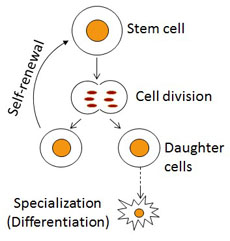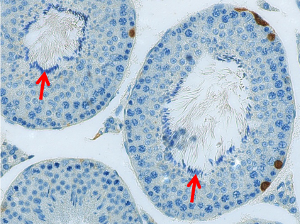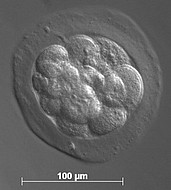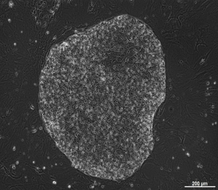Stem Cells - where and why?
Adulte stem cells
Most of the cells (~ 10 trillion or even more) that constitute our body are specialized cells. Muscle cells, for example, are able to contract, red blood cells (erythrocytes) deliver oxygen to the different organs and tissues of an organism while hepatocytes are found in the liver and do produce bile and store glycogen. To date, several hundreds of different specialized cells could be identified in the mammalian body.

In addition to such specialized cells, also functionally unspecialized cells are present in the body, so-called stem cells. Stem cells are thereby characterized, that by cell division they can undergo self-renewal in an undifferentiated
state. At the same time they can differentiate into specialized daughter cells. They appear to be present in all organs as a pool of cells which (i) provide new cells for normal tissue homeostasis and (ii) are able to repair a tissue after injury (depending on the organ at least to a certain extent).

Adult stem cells are organ-specific and restricted in their developmental potential. Their derivatives can generate only one (unipotent) or a few (multipotent) mature cell types of a specific organ or tissue. Hence, under normal conditions, adult stem cells cannot develop into cell types characteristic of other organs. The best-characterized stem cell type is the hematopoietic stem cell (HSC), which is the progenitor of all different blood cell types. The HSC is also the only stem cell type that is used routinely in clinical application (during bone marrow transplantation).
Embryonic stem cells
In contrast to adult stem cells, which are limited in their developmental potential, embryonic stem cells (ESCs) appear to be unrestricted in their developmental potential – they are pluripotent. In other words, ESCs are able to differentiate into all cell types of the adult body. ESCs are derived from a preimplantation embryo, which is an embryo of a very early developmental stage (see figure). In primates, the respective stages are reached five to eight days after fertilization. The embryo’s diameter at that stage is about 0.1 mm. The cells, which later form the body of the fetus are still unspecialized (undifferentiated): each single cell can develop into any cell of the adult body. When these cells are isolated and kept in cell culture, they can self-renew over many years and, very importantly, do keep their potential to form any adult cell type. In contrast to that, their counterparts in a developing embryo are pluripotent only for a few days and then develop irreversibly into more differentiated cell types. To date, numerous specialized cell types have been derived from ESC.


The generation and use of human ESC lines is ethically controversial and in Germany banned by the German Embryo Protection Act. According to that act, human embryos may only be used to achieve a pregnancy of that woman who donated the egg from which the embryo has developed. However, the "Gesetz zur Sicherstellung des Embryonenschutzes im Zusammenhang mit Einfuhr und Verwendung menschlicher embryonaler Stammzellen“, shortly referred to as "stem cell act" allows the import of some specific human ESC lines from abroad to Germany if these cells are used for high ranking research which absolutely relies on human ES cells. The Stem Cell Biology Unit doesn't use human ES cells. We focus on non-human primate stem cells.
Induced pluripotent stem cells (iPS cells)
Since a few years it is possible to reprogram adult (differentiated) cells to pluripotent stem cells. What does this mean? Connective tissue cells (fibroblasts) for example, which can be obtained from small skin biopsies (and therefore are ethically acceptable), can be easily kept in cell culture. If a set of genes, which normally are highly active in embryonic stem cells, are expressed in connective tissue cells, these cells become pluripotent. They are reverted to a state in which they, like embryonic stem cells, are not restricted in their potential to develop into any kind of specialized cell type. Since no embryos are needed for the generation of iPSC, research on human iPSC is, unlike human embryonic stem cell research, legally not restricted in Germany. For the development of this revolutionary technique of iPSC generation the Japanese stem cell researcher Shinya Yamanaka was awarded the Nobel Prize for Medicine and Physiology in 2012.
What for?
Pluripotent stem cells can be differentiated into many clinically relevant cell types. For instance, these include nerve cells and cardiomyocytes. This differentiation potential of pluripotent stem cells awakes the hope that cell-degenerative diseases may be curable using stem cells. Indeed, it appears to be possible to functionally replace for example infarcted heart tissue by new heart tissue generated in cell culture. However, regarding safety and efficacy, these potential new therapies require extensive and long-term preclinical testing in relevant animal models.
